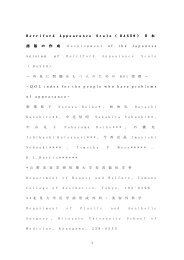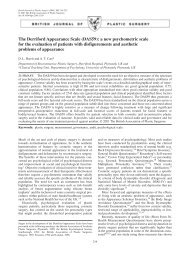DAS-59 - Derriford Appearance Scales
DAS-59 - Derriford Appearance Scales
DAS-59 - Derriford Appearance Scales
You also want an ePaper? Increase the reach of your titles
YUMPU automatically turns print PDFs into web optimized ePapers that Google loves.
204<br />
Tony Carr et al.<br />
Construct validity of the new scales was further supported by the nding that mean<br />
pre-operative scores for the plastic surgery patients were signicantly higher than those<br />
for the pre-operative control surgery patients on all three scales (e.g. CRS: 128.3–95.3;<br />
t 5 6.2, p < .001) and the pre-post operative changes for the plastic surgery patients<br />
were large and signicant (e.g. CRS: 128.3–99.1; t 5 5.1, p < .001).<br />
These results clearly indicated that the new scales had excellent potential to provide an<br />
appropriate instrument to meet the present aims. Feedback from the plastic surgery<br />
patients was strongly positive regarding the scales’ content which they judged to<br />
encompass satisfactorily all relevant aspects of appearance-related distress and dysfunction.<br />
However, the scales were too long in their existing form and some ambiguities<br />
in wording needed improvement.<br />
STUDY 2<br />
All patients aged 18–60 on the plastic surgery waiting list at <strong>Derriford</strong> Hospital,<br />
Plymouth were mailed revised versions of the CRS, PDS and PRS and an explanatory<br />
letter over a three-month period. Of 1010 patients mailed, 606 patients had responded<br />
after one follow-up letter. This clinical sample reected the typical range of plastic<br />
surgery cases and consisted of patients with aesthetic problems of appearance (small/large<br />
breastedness, nasal deformities, loose abdominal skin, etc.; N 5 415), patients with<br />
congenital and acquired disgurements and deformities (e.g. naevi, scars, facial palsy;<br />
N 5 213) and patients waiting for treatment of conditions which were not principally<br />
problems of appearance (e.g. functional hand surgery; N 5 88). Thirty non-responders,<br />
chosen at random and contacted by telephone, indicated that their failure to respond<br />
related to the length of the test material and limited time available. None was distressed<br />
by the content of the scales.<br />
The three scales were rened rst by within-scale item analyses, retaining items with<br />
item–whole correlations of .5 or higher and by within-scale factor analyses (principal<br />
components and varimax) retaining items which loaded higher than .5. From the retained<br />
items, those which duplicated similar clinical information in more than one scale were<br />
identied and those with the higher item–whole correlations and greater face validity on<br />
the basis of clinical experience were retained. Finally, the items which had not been<br />
retained were reviewed and some with particularly high face validity for a clinical<br />
population, which had been excluded by these procedures (N 5 3), were identied for<br />
inclusion in the rened item set. Of the 136 original items, 57 were thus retained. Scores<br />
on the 57 retained items were extracted from the original 606 data sets and their<br />
total correlated with the original scale totals yielding high coefcients (CRS 5 .98;<br />
PDS 5 .96; PRS 5 .96).<br />
The rened set of 57 items was reorganized into a single scale. As many disgurements<br />
can be associated with physical discomfort and difculty, two new items were added to<br />
assess these dimensions and to improve the acceptability of the rened scale for clinicians.<br />
The <strong>59</strong> items are briey described in Table 3, reported in the results for Study 3 below.<br />
They are constructed to appropriately assess the frequency and intensity of relevant<br />
aspects of affect, cognition and behaviour associated with living with problems of<br />
appearance. A Likert-style response format is used throughout, including a ‘not<br />
applicable’ option. The time frame of the items is contemporary, with respondents





